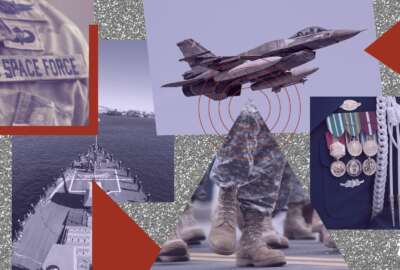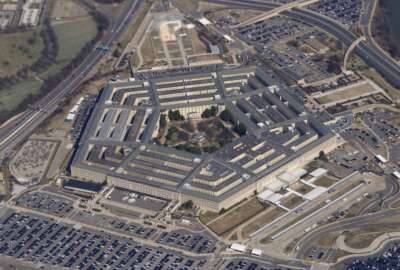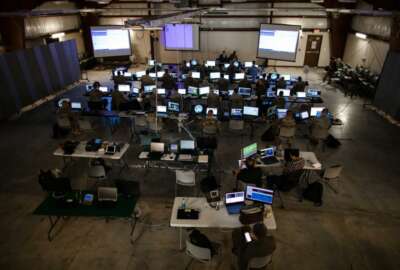New defense civilian workforce pipeline in the works, starting with 4 universities
The department is using the new Defense Civilian Training Corps to build its acquisition workforce, with hopes to expand the program to other disciplines soon.
College and university ROTC programs play a huge role in training the military’s future uniformed officers — in fact, they produce more officers than the military’s own academies. But there’s nothing defense-specific approaching that scale for DoD’s civilian workforce. Officials are now trying to change that via a new Defense Civilian Training Corps, which is now up and running at four universities.
Congress first mandated the new DCTC program as part of the 2020 Defense authorization bill, and DoD formally launched it a year ago at four universities: Virginia Tech, Purdue, the University of Arizona, and North Carolina Agricultural and Technical State University. But the department still considers it a pilot program for training and attracting future civilian employees and is looking for ways to expand it beyond the 89 students who participated in the first year.
For now, the department is using DCTC only to train and recruit the Defense acquisition workforce, with hopes to expand the program to other disciplines soon.
But unlike many of DoD’s other academic programs, the focus isn’t mainly on students pursuing technical degrees. Those students make up only about half of the program, said Garry Shafovaloff, the program manager for DCTC.
“We create a cohort of students who work together with various functions — technical and non-technical — to acquire everything that equips our military for deterrence, so we take the work as it’s done today in DoD and just take that model into the classroom,” he said during a DoD workforce development forum organized by George Mason University and the Acquisition Innovation Research Center. “So our engineer degree-seeking students are sitting with our business and our supply chain and our finance degree-seeking students. Through the curriculum design, we kind of force them to learn about each other’s functions, and then we give them the context of DoD acquisition and how those functions and people work together, and that it’s teamwork.”
Project-based and academic work
The in-class portion of DCTC, for now, includes four 300-and-400 level classes, including an introduction to the fundamentals of civilian government service and the DoD acquisition system.
But that junior-and-senior level academic coursework is only part of the program. Between those two years, during the summer, students do project-based internships based on actual problems various DoD components are trying to solve.
To gather candidates for those projects, DCTC turned to the department’s various agencies and field activities. For this past summer’s internships, the program received 89 separate project proposals from across DoD.
“We send teams of two to four scholars to each military organization around DoD, and each team includes an engineer and non-engineers, and then they have their project work for the summer. They’re getting exposure, meeting senior leaders and acquisition professionals, and they’re working on a problem that needs to be solved,” Shafovaloff said. “The problem sets have spanned across artificial intelligence applications, satellite maneuvering, hypersonic propellants, data analytics, force shaping. So through the classes and the preparation in the classes, the students then go do the work during the summer, then they come back for their senior year.”
Scholarship-for-service
DoD structured DCTC as a scholarship-for-service program. Each student gets a full academic scholarship plus a monthly stipend. In return, they’re obligated to work for DoD for at least two years after they graduate.
But Shafovaloff said those new employees are able to hit the ground running in ways most 20-somethings just joining the workforce can’t, not just because of the training program, but because their security clearances are ready to go on the first day they start work. The Army’s Combat Capabilities Development Command acts as the sponsor for security clearances within the DCTC program and helps shepherd students through the clearance process.
“We actually had almost all of the scholars with background checks completed before they started their summer internship, and they’ll definitely have their security clearances by graduation,” he said. “So it’s a rigorous preparation. They’ve had DoD classes, they’ve actually done work, and they’ve gotten to meet the professionals doing the work every day. Those professionals turn into mentors and coaches, and we’re creating networking. They’re getting experience across how engineers think and how business people think, and how all that comes together.”
Expanding defense civilian corps beyond pilot stage
As for what’s next, the law that created DCTC specifically called out career fields in acquisition, science and engineering, but it also gave DoD wide latitude to use the program for any areas where it has critical skills gaps. The legislation also called for an aggressive schedule that DoD hasn’t met: a total of 20 schools and 400 students by August 2023.
One logical area for expansion would be the other 20 universities that are part of the Acquisition Innovation Research Center, the organization that’s helping to develop the program together with DoD’s chief talent management officer, chief digital and artificial intelligence officer, and Defense Acquisition University.
Shafovaloff said whichever domains DCTC expands into next, one common thread will be digital literacy and technical literacy.
“We believe it’s time for a program similar to what we’ve done for the military to attract and to prepare people rigorously for public service. We’re firming up the design of the program, and we will be providing alternatives for expansion in the future,” he said. “We definitely have had congressional support broadly, and a lot of interest from many universities who have said, ‘Hey, why haven’t we done this before? Let’s get going.’ One of the benefits of DCTC within the labor market framework is getting the word out … it’s like a lighthouse about public service. You can serve the national security team — in our case, DCTC — but there’s many other avenues to do that, and I certainly hope that we are able to expand this program for all the domains in the future.”
Copyright © 2025 Federal News Network. All rights reserved. This website is not intended for users located within the European Economic Area.
Jared Serbu is deputy editor of Federal News Network and reports on the Defense Department’s contracting, legislative, workforce and IT issues.
Follow @jserbuWFED






